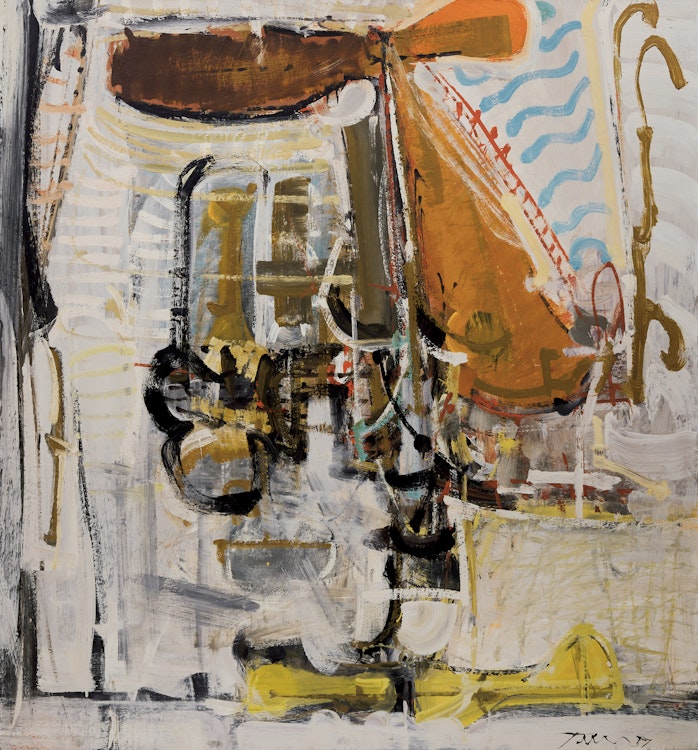Variation on a Variation, 1957 by Harold Barling Town

Harold Town
Variation on a Variation, 1957
oil and lucite on board
signed and dated 1957 lower right; titled and dated 1957 to an exhibition label on the reverse
48.25 x 45 in ( 122.6 x 114.3 cm )
Auction Estimate: $18,000.00 - $22,000.00
Price Realized $66,000.00
Sale date: November 27th 2024
Mrs. O.D. Vaghan, Toronto
Estate of Robert Noakes
"Painters Eleven Exhibition", Park Gallery, Toronto, 31 October-16 November 1957
"Harold Town: A Retrospective", Art Gallery of Ontario, Toronto, 16 May-6 July 1986
David Burnett, "Harold Town: A Retrospective", Toronto, 1986, reproduced page 96, listed page 218
Iris Nowell, "Painter's Eleven: The Wild Ones of Canadian Art", Toronto, 2010, reproduced page 178
Share this item with your friends
Harold Barling Town
(1924 - 1990) Painters Eleven, OSA, RCA
A lifelong Torontonian, Harold Town was one of Canada’s foremost abstract expressionists. After graduating from the Ontario College of Arts (now, OCAD University), he worked as a commercial illustrator for many years. In 1954, he became a founding member of the experimental painter’s group, Painters Eleven, a name he coined, himself, along with Jack Bush and Jock MacDonald.
Town’s work went beyond paint, though: he experimented with all kinds of different methods and materials. He often employed a lithography machine to ink his paper in different ways (his single autographic prints). A propane blow torch was occasionally used to burn his paper or canvas. And he particularly loved collage, stating, “it’s marvelous to think of the garbage of our age becoming the art of our time.” According to Gerta Moray, these collages are closely connected to his abstract expressionist painting: “the compositional modes of his collages share the aesthetic of his paintings: they spread out to fill the surface yet are given focus as configurations by areas of drawing in ink or paint.”
Two of Town’s single autographic prints were the first works by the artist to be acquired by the National Gallery of Canada. The NGC then selected him to represent Canada at the 1956 Venice Biennale, along with Jack Shadbolt and Louis Archambault.
By the end of the 1960s, Town had exhibited his work internationally and represented Canada at the Venice Biennale twice. He garnered covers of Maclean’s and Time magazines and became a hero of Canadian art. At one point his name was “synonymous with art in Toronto.” He received an honourary doctorate from York University and the Order of Canada.
In the 1970s, Town faced criticism for remaining in Toronto instead of going to New York to pursue Pop Art and minimalism. Town asserted that these claims by art critics suggested a subservience to the New York trends. He remained true to his roots in Toronto.
In the 1980s, Town returned to figurative painting. His bright colours and simple lines were playful, ironic, and influenced by folk art. In his series, Musclemen, he painted body builders in cartoonish proportions and colours, with giant muscles and tiny heads. Apparently, Town “came upon an international bodybuilding competition and was captivated by the human body performing its muscle-bulging poses as living sculpture.” Moray asserts that this series ironically comments on “the masculine ideal in popular culture.” This assertion is made more interesting when considering that he also painted a small number “Muscles Ladies.”
Four years before his death, Town was given a long overdue retrospective exhibition at the Art Gallery of Ontario. Town’s death in 1990 of cancer was felt profoundly by the artistic community. Pierre Burton wrote “Town was a great artist with an insatiable intellect.” David Burnett, the curator of his retrospective wrote: “Our response to his death must be to begin the process of understanding his achievement as a totality, of facing all of his work in the present” The enticing legacy of his work continues to captivate and intrigue audiences today.
Literature Sources
Iris Nowell, “Harold Town”, Vancouver, 2014, pages 175-78
Gerta Moray, “Harold Town: Life and Works”, Art Canada Institute, 2014 (www.aci-iac.ca/art-books/harold-town)
We extend our thanks to Scarlett Larry, York University graduate student in art history, for writing and contributing this artist biography.

